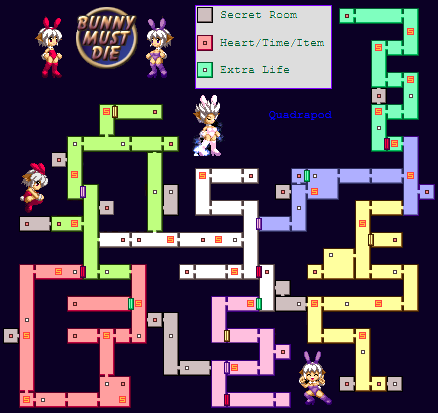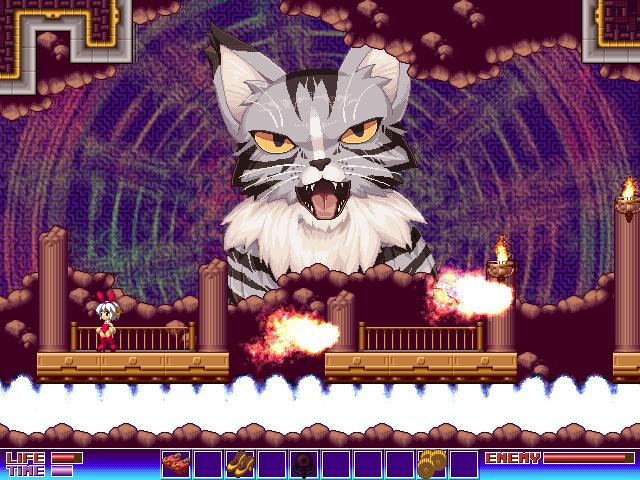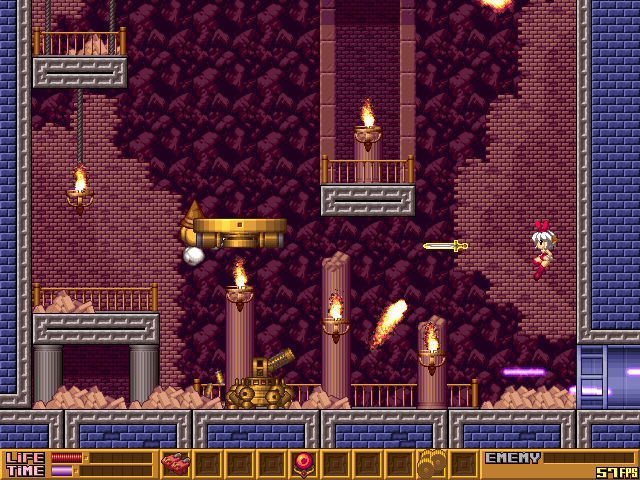Last updated on December 19, 2013
NOTE: This game is strange, weird, difficult, and the aesthetic probably turns lots of people off right from the start. As such, only Zachery Oliver will participate in this particular review.
Bunny Must Die: Chelsea and the 7 Devils defines the “cult” classic. Originally conceived and released by Japanese indie group (read: one guy) Platine Dispositif, it finally found release in the West by localization group Rockin’ Android sometime in 2012. By the time I got my hands on this little gem of a game, Bunny Must Die appeared on Steam and endeared itself to my sensibilities immediately. That is, it present a huge challenge and makes me incredibly angry at a stupid video game.
At first glance, I would not expect anyone to confuse this game’s genre: a platformer with exploration elements in the vein of Metroid and post-Symphony of the Night 2D Castlevania. It hits all the standard tropes of this style in aesthetics, taking equal parts Castlevania (heck, one section looks just like Dracula’s Castle and you fight a vampire-esque boss) and Metroid (OH, secret underground lab!). However, Bunny Must Die completely eschews the self-seriousness of both by making everything quirky and endearing rather than isolating or intimidating.
Frankly, it’s just strange and weird, the good kind of Japanese weird with great animation and a cute anime aesthetic. The main character, after all, is little more than a woman in a one piece bathing suit turned into a bunny with cat ears…also? And the plot consists of some nonsense about a post-apocalyptic world of cats in the year 1999X, and time travel, and evil bunny time lords who want to rule everything. If anything, it lets Platine Dispositif emulate the genre while poking fun at its laughable (out of context) tropes in light spirits. I mean, any game where you fight floating pumpkins, giant adorable cats, and a man whose groin shines so bright it will kill you if you dare look upon certainly does set an expectation.
And that expectation, somehow, completely turns your ideas of this game on its head. Unlike its predecessors, Bunny Must Die lives up to its namesake by killing Bunny repeatedly, over and over again. The beginning stages, where you learn the mechanics, hit you like a brick wall when you’re not paying attention to what’s in front of you. Every mechanic seems utterly familiar if you played any previous Metroid and Castlevania game (like objects well-hidden in the overall game world), yet the developer nuances them in a way that goes against your muscle memory.
Let me provide a few examples. Weapons with the first character, Bunny, work just like classic Castlevania games in that you pick them up and overwrite your previous weapon. The weapons range from the standard dagger projectile to a close range sword, and each works for certain sections rather than others. The sword rips through most enemies, but getting close presents a constant risk in a game where health doesn’t refill unless you save or pick up heart containers (the equivalent of a Metroid Energy Tank). The Sylph Sword allows safe attacking from range, but it barely does any damage. The Ball and Chain instantly destroys some enemies, yet it will bounce around uncontrollably once let loose. The variety on hand means each weapon remains useful throughout the game, yet you must knock out candles (just like Castlevania!) or else you might lose your desired aggressive force.
Unlike in Bunny Must Die’s inspirations, weapons never become more powerful, meaning that you never get that unbalanced, albeit satisfying “I have gathered everything in the castle” feeling. The game wants you to rely on knowledge and skill rather than accumulated playtime, a feature I most definitely appreciate.
If anything, the platforming raises an even bigger question mark. Nearly every jump requires precision and adapting to a new, counter-intuitive jump system. Like Metroid, pressing jump and then a direction left or right will cause your character to jump straight up with little horizontal momentum. In the same vein, pressing left or right and jump at the same time will cause a spin jump. Unlike in Metroid, however, most segments in Bunny Must Die absolutely require one type of jump over the other. The spin jump differs in height from the normal jump, and given the long vertical rooms in this game, one mistake could lead to a reset or worse (death by spikes or enemies, more than likely). Words cannot convey how strange this feels, and even after thirteen hours I never found myself familiar with it. Eventually, obtaining the dash, wall jump, and Space Jump-equivalents turn Bunny into a speed machine, but the jump puzzles remain even with these new abilities. You also can’t change the direction you face in the air, which complicate combat while jumping.
Bunny Must Die tries to mess with your muscle memory even further by introducing Super Mario Bros. head stomps. In this case, Bunny’s high heel stomp always satisfies, and by landing on an enemy without spin jumping you’ll stomp them to death; this also works on certain dangerous terrain features (like, you know, laser beams) and turns into an essential platforming element.
You’ll need all of these elements for the game’s many difficult boss battles. Most bosses will outright confuse you on the first try, and much depends on your weapon choice and current equipment. Of course, there’s a number of viable strategies and means, but most of them come down to skillful use of the controls. Some require good timing/avoidance skills almost in the vein of a bullet hell shooter, as projectiles and other nasty things fill the screen to kill you dead. The final bosses remind me of the best Treasure had to offer, a cross between Gunstar Heroes and whatever strange creature CAVE throws into the mix at the end of some shmup. Trust me, you’ll remember them (and die to them) while enjoying the pattern-learning process.
Unless, of course, you see fit to simply avoid a boss entirely which the game allows if you’ve got the skill and the planning for it. The essential element of Bunny Must Die’s primary mode comes from an exhaustive time manipulation mechanic. As you might expect, it comes into play during the game’s many puzzles, and rewinding time will allow you to open timed gates and avoid some boss fights with the right implementation. Imagine, this game emerged two years before Braid even existed on the market, and I’d wager the design actually improves on Blow’s implementation.
Mostly, that’s due to Bunny Must Die’s obvious focus in speedruns. Literally, you can plow through the game in under thirty minutes given the right planning. Since saving the game adds time to the clock, you’re encouraged to blaze through the game while getting 100% of the items – it’s literally insane to watch. Those speedruns require an intimate knowledge of the game in every respect, especially in knowing how time affects each room. Some enemies become immune to damage, while others actually turn into platforms; frankly, I know nothing about this game even while dumping so much time into it. There’s almost too many ways to shave time from your total, adding quite a replay value if you catch the perfection bug. This must require an impeccable level of design required to make that work, so I applaud the single guy who designed this whole thing with a virtual English language high five.

In that sense, I’m not exaggerating to say that Bunny Must Die presents a great deal of hidden depth within every mechanic – given that there’s only three buttons, each one goes for incredible nuance for a seemingly simple control scheme, and succeeds more often than not. Even then, Bunny Must Die will punish you for being bad at the game, so learning its system turns into a stiff challenge on top of the devious level design.
Furthermore, just to add to the fun, a second character uses the same map but completely changes the way the entire game plays into a puzzle-platformer (and you must play both to reach “the end”). I won’t spoil it, but rest assured a second playthrough (once you get seven time capsule upgrades and “beat” the game for the first time) will remain utterly necessary. If you made it through the first challenge, you’ll want the second course.
Unfortunately, Bunny Must Die’s greatest strengths also reveal its greatest fault: inaccessibility. If the aesthetic turns you off, than the game’s sheer cliff difficulty curve will put your down for the count. This is an incredibly niche game that I spent 13 hours powering through only because I am a complete and utter masochist. I will not let the game’s hilarious difficult, especially compared to other games in the genre, beat me. Most people just won’t have the patience, and it makes me sad. In no way do I lament its difficulty or its need for speed, though; it defines Bunny Must Die as a game demanding your very best. If not, just go home.
The vertical nature most rooms will certainly turn into a barrier. requiring adept platforming segments will frustrate you if you. The aforementioned jumping controls will often fail you as you learn to adjust to their oddities. Frustration builds, and so will anger, reverting you to your base instinct – in this case, though, your body’s return to primal instincts ( and muscle memory) tends to fail you entirely here. It also fails to string the player along sometimes; I found myself lost on more than one occasion as I missed an item that I needed to progress. If you hate feeling lost, add that to the list of cons.
Still, I retain my own quibbles with the controls. The dash remains one of the most important skills in the whole game, allowing fast travel, escapes, and the wall kick ability. For whatever reason, though, this essential ability isn’t tied to a button like in Mega Man X. Instead, you must double tap left or right and hold it down to dash, which makes my brain hurt on so many levels. I played the game with a PS3 controller, and that simply isn’t accurate enough to always render a fast double tap input. This unfortunate oversight causes more than its fair share of deaths if you’re off by even a little bit (as I will harp on, muscle memory turns into your worst enemy).
I will add, as an aside, that the second character’s inability to use all abilities at once (she can only scroll through them one at a time) becomes a royal pain once you hit boss fights where you WANT to switch to another ability quickIy. I imagine they implemented her diverse (and overpowered) skill ensemble for balance reasons, but it turns the character’s style into crazy territory when you’ve got ten unique weapons to use.
If anything, this game frustrated and crushed me into a fine powder. I don’t think I have slammed inanimate objects in quite a while during a game, yet it remained quite fair in how it punished my incompetence. Still, it’s hard NOT to get angry. But the Bible tells me NOT to get angry, multiple times like in James 1:
19 This you know, my beloved brethren. But everyone must be quick to hear, slow to speak and slow to anger; 20 for the anger of man does not achieve the righteousness of God.
But there’s a good kind of anger, and the bad kind of anger. The good kind usually arises in the context of moral issues where we feel passionate about something. In this case, the game makes me so angry because I want to win and conquer it. The game won’t give up the goods, and my brain won’t give up the endorphins, until I win. I love this constant struggle of video games where you invest yourself wholly in the experience. Mastery’s a wonderful thing, and we should all strive to master something…even our anger.
The Bible, I think, means the irrational, hot-tempered style of anger that break relationships for no good reason. I am talking about the kind that motivates you to action, more passion than “anger” in this sense. So have at it with video games, really!
Still, expectations will sully your experience with Bunny Must Die. Remove them, and you will enjoy it. The stiff challenge, along with the need for trial and error (this goes for finding items as well as platforming and boss fights), will certainly reject most gamers outright. If you want a traditional “Metroidvania” to fill your time, you will not find it here. You will die and repeat sections over and over again, but the game often forces you to go through these sections again as you traverse the map. Impatience will kill you. And if you get angry easily, please avoid this.
Knock the rating down a star if you dislike difficult games.
Intended Audience: Bunny Must Die contains a few bits of cleavage (due to the one piece bathing suit and a certain item you can obtain later in the first playthrough) and LOTS of cartoon violence, though the presentation goes purely for 16-bit abstraction rather than anything realistic.



